読みもの
Arita Toji no Sato Plaza
JP: 有田陶磁の里プラザ/ありたとうじのさとぷらざ
A street focussed solely on Arita ware, with over 20 shops selling a wide range of Arita ware, from articles for daily-...
Aritamachi Rekishiminzoku Shiryokan (History and Folklore Museum of ARITA)
JP: 有田町民族歴史資料館/ありたまちれきしみんぞくしりょうかん
Located just beside the Izumiyama Quarry. The museum tells the history of Arita with displays and documents abou...
Chosen Shuppei (Japanese Invasion of Korea)
JP: 朝鮮出兵/ちょうせんしゅっぺい
The military dictator Toyotomi Hideyoshi invaded Korea in 1592 and 1597 in a campaign to expand overseas territory. Many Korea...
Gosaide
JP: 五彩手/ごさいで
Pottery or porcelain, overglazed with blue, green, yellow, violet and red, then fired. The term gosaide is used to refer both to the ...
Gottfried Wagener (1831-1892)
JP: ゴットフリード・ワグネル/ごっとふりーど・わぐねる
German chemist, served as a technical advisor for the ceramic industry in Arita in 1870.
During his stay in Arita, ...
Goyogama (Official Kiln)
JP: 御用窯/ごようがま
A kiln, organized by an official clan in the Edo period to make wares exclusively for the nobility, used at parties among the lords ...
Hajiki
JP: 土師器/はじき
Plain and unglazed earthenware, made from the Kofun period (3rd-7th century) to the Heian period (9th-11th century) in Japanese histor...
Hanyo (Clan Kiln)
JP: 藩窯/はんよう
Kilns that were run by the nobility in Edo period Japan (1615-1868). In the case of the Nabeshima clan, they created the most refined ...








